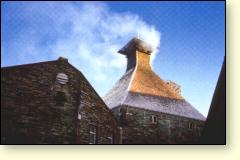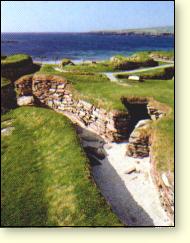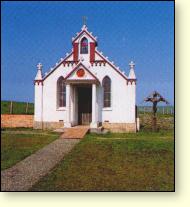
 |
|
Location: Kirkwall, Orkney KW15 1SU
Roads: Holm Road
Hours: April - October, 10am - 5pm Mon - Fri
also July - August, Sat/ Sun 12.00 - 5.00pm
November - March, tours only at 2.00 and 3.30pm, Mon - Fri
Tours every 1/2 hour; last tour at 4.00pm
Group bookings by appointment
Reception centre, audio-visual presentation and shop
Phone: 01856-874619
Homepage: www.highlandpark.co.uk
|
Text from The Whisky Trails, Copyright © Gordon Brown 1993:
In the course of announcing his 1993 Budget to the House of Commons, the Chancellor of the UK Exchequer raised a glass of malt whisky to toast the success of the Scotch whisky industry; he then proceeded to raise the duty on wines but not on spirits. The whisky he waved before the nation watching on television was Highland Park 12-year-old.
Some of the Orkney islands seem to lie only feet above the water, scattered like great green carpets across the horizon; others loom blue-grey before you, hummocky and ice-rounded, with undoubted power and mass. Despite words to the contrary, Orkney does indeed have trees although they cluster in hollows and those nearest the prevailing winds are leafless and perished from the salt-spray they bear. Spaciousness and timelessness are what you feel in these landscapes, but the towns have their creature comforts. The little court of Orkney was said to be the most refined and elegant in the whole of Europe in the 14th century, and you can see what they meant with a glance at the Earl’s Palace and St Magnus Cathedral.
The people of Orkney have been shaped by influences from all directions; as with any distinctive community, they are aware of their rich history and it is never a chore for them to talk about the uniqueness of their islands. Norse influences abound in islands that have been settled since 6000 BC; Orcadians went to Canada to work in the Hudson’s Bay Company and married into the Cree Indian tribes there; certain residents of Westray are called Dons, descending, as they do, from a boatload of survivors from the Spanish Armada who were shipwrecked on its rocks.
Illicit distilling in Orkney was difficult to contain because of its remoteness. There was no stigma whatsoever associated with smuggling in the late 18th century because people were fed up with the extent to which the government heaped duty on to a wide range of goods to pay for the war with France. Tea, sugar and salt, in addition to whisky, were dutiable and the gin producers of the south were shamelessly protected by Parliament against prospective inroads by Scotch whisky. As a result, respectable people had no compunction about distillation on the quiet; indeed the provost (mayor) of Kirkwall and the government’s own resident naval commander were among the leading smugglers in Orkney.
At the tail-end of the 18th century, none of the Orcadian distillers was permitted to export beyond the islands but extensive smuggling networks made it available in the Lowlands. Orkney whisky was of very high quality and Kirkwall provost, Thomas Traill, must have had excellent connections to enable him to transport his product. In 1805, the Excise blitzed the outer Orkney islands and seized many illicit stills so Traill played safe and opened a licensed brewery and distillery in Mill Street in Kirkwall. He worked with Magnus Eunson who had run an illicit still since 1798 on Kirkwall common land and it is thought that this was the original distillery on the Highland Park site. Eunson was said to have stored his full casks under the pulpit of a local church, away from the attention of the Excise officers. It must have been a fragrant atmosphere in which to sing hymns.
On one famous occasion, Eunson got wind of an impending raid. When the officers burst in, a funeral service was under way, with the coffin resting on supports covered with a white cloth. In case the covering might be raised to reveal the casks on which the coffin lay, the word, ‘smallpox’, whispered in an officer’s ear, sent the party hurrying off without any further examination.

The ´rabbit warren´ of Skara Brae was, 5000 years ago, a complete prehistoric village.
|
Two years after the new law of 1823 at last made distilling a viable business proposition, Robert Borwick set up his Highland Park operation. Ironically, the buildings were owned by John Robertson, the Excise officer who had finally arrested Magnus Eunson a decade earlier. The main attraction of the site were the springs of crystal-clear water from a pool at Cattie Maggie’s, and the Borwick family had a hand in running the distillery for the next 35 years. When James Borwick inherited the distillery in 1869, he quickly sold it on since he felt that ownership of such a business would be inappropriate to his standing as a church minister.

The Italian Chapel was built by Italian prisoners of War during World War II.
|
In 1883, Sir Donald Currie visited Kirkwall with his liner, the Pembroke Castle, on its maiden voyage. He was greatly impressed by the quality of Highland Park whisky and took a quantity away when the voyage continued. By all accounts the King of Denmark and the Emperor of Russia, whom he entertained on board later, were equally enthusiastic about the whisky. More recently, Winston Churchill and Her Majesty the Queen have shown interest in the distillery and its whisky. The distillery is now owned by Highland Distilleries.

The ´rabbit warren´ of Skara Brae was, 5000 years ago, a complete prehistoric village.
|
Most of the warehouses have traditional beaten-earth floors and they contain about 40,000 maturing casks. There are four stills. The floor maltings still in use at Highland Park are one of the few remaining in Scottish distilleries. About 600 tonnes of barley can be laid out on the V-shaped floors, where it is regularly turned to control heat build-up. The malt is dried in the kiln with a medium peating effect. The peat comes from the company’s own moss at Hobbister Hill, near Scapa. It is cut in April, then stacked and dried over the summer for storing before use. The heather with which it is covered adds an important nuance to the final flavour.
The Whisky
Text from The Whisky Trails, Copyright © Gordon Brown 1993:
Highland Park is full and resonant in flavour with smoky tones all through. It is not heavy, showing silky, slightly creamy texture. It is usually bottled at 12 years old and mainly 40% vol., but a 1967 vintage at 43% vol. was recently available. Independent bottlings range from eight- to 12-year-old and vintages go back to the 1950s.
Source of water
Cattie Maggie's Spring
Of interest
Text from The Whisky Trails, Copyright © Gordon Brown 1993:

The Italian Chapel was built by Italian prisoners of War during World War II.
|
• Skara Brae is a kind of prehistoric block of flats dating from 3000 BC and complete with storage boxes, furniture and wall-shelving, all made of stone.
• Maes Howe is a chambered tomb, regarded as the finest prehistoric architectural achievement in Europe. It is contemporary with Skara Brae and at the winter solstice sunlight shines directly down the passage to the chamber within the mound. The graffiti, scratched on the walls in runes by Viking tomb-robbers, date from the 12th century.
• Stromness, built with its shoulder to the sea, is an interesting little town. The museum is excellent and lies opposite the site of the old MacConnell distillery, founded in 1817 and silent from 1928.